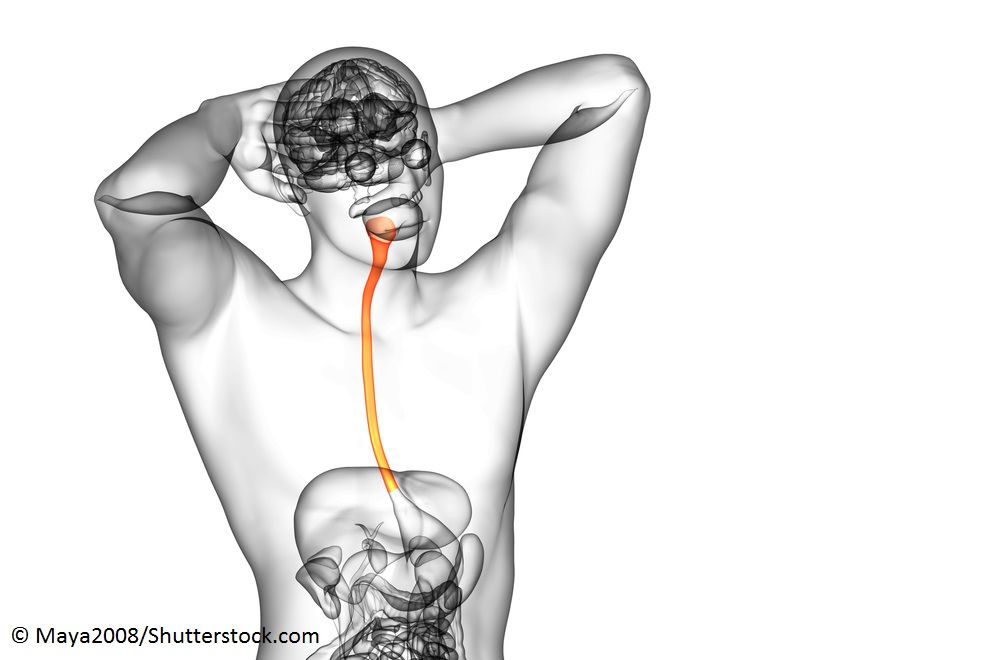- Clinical Technology
- Adult Immunization
- Hepatology
- Pediatric Immunization
- Screening
- Psychiatry
- Allergy
- Women's Health
- Cardiology
- Pediatrics
- Dermatology
- Endocrinology
- Pain Management
- Gastroenterology
- Infectious Disease
- Obesity Medicine
- Rheumatology
- Nephrology
- Neurology
- Pulmonology
Understanding Eosinophilic Esophagitis: A Primer for Primary Care Physicians
Sometimes called "asthma of the esophagus," EoE requires early detection for optimal management. This 2015 ACG presentation reviews Dx and Rx for primary care.
© Maya2008/Shutterstock.com

Eosinophilic esophagitis (EoE) is a prevalent condition increasingly encountered by specialists and primary care physicians alike. It is sometimes referred to as “asthma of the esophagus” and both EoE and asthma or other atopy are frequently associated. When a young patient (particularly male) with longstanding asthma states that he or she is having difficulty swallowing with progression from solid to liquid food dysphagia, EoE must be on the differential.
As the study of this disease has become a dynamic field with an evolving understanding of the diagnosis and treatment, all caregivers are challenged to find the right balance in symptom management and prevention of disease complications.
In his presentation at the 2015 American College of Gastroenterology Scientific Session titled “What Are the Treatment Endpoints for Eosinophilic Esophagitis” Dr Nicholas Shaheen, professor of medicine and epidemiology, University of North Carolina, Chapel Hill, NC characterized the disease and focused on the challenge of avoiding complications.
Diagnosis of EoE is a clinicopathologic challenge. It is defined by symptoms related to esophageal dysfunction, eosinophilic predominant inflammation on esophageal biopsy (consisting of >15 eosinophils/high power field), mucosal eosinophilia isolated to the esophagus, with persistent eosinophilia after proton pump inhibitor therapy. Secondary causes of EoE must be excluded (ie, eosinophilic gastroenteritis, hypereosinophilic syndrome, celiac, Crohn disease, vasculitis, graft vs. host disease). While response to treatment buttresses the diagnosis, it is not required.
The goal of therapy is to improve symptoms and, equally important, to prevent complications and disease progression. How will we know if the treatment is successful? There are several possible treatment outcome measures that may be assessed such as symptom improvement, histology on follow up endoscopy and avoidance of complications.
Treatment options are focused on pharmacologic therapy, dietary therapy, and at times endoscopic therapy, such as dilation if stricturing occurs. Pharmacologic focus is aimed at the reduction of inflammation with data supporting therapies such as: topical/systemic corticosteroids, leukotriene antagonists, mast cell stabilizers, immuno-modula-tors, and biologics. Topical corticosteroid recommendations include fluticasone 220 µg inhaler (4 puffs BID), or budesonide 1 mg BID mixed with a thickening agent. Most effective use for MDI is to instruct the patient to swallow the medication during breath hold (the exact opposite of what you want an asthmatic to do!) or with oral agents to remain NPO for 30 to 60 minutes after administration of medication. Length of therapy is 8 weeks followed by repeat endoscopy. Prednisone may be useful if topical steroids are not effective or if rapid improvement of symptoms is needed.
While pharmacologic therapy is certainly beneficial, dietary modifications should also be recommended. This is supported by the thought that food allergens may contribute to the pathogenesis of EoE. Strategies for dietary therapy include: 1) an elemental diet and 2) the six-food elimination diet (excluding milk, soy, egg, wheat, nuts, seafood/shellfish x 6 weeks) or variations on this theme. The choice of the specific dietary approach should be tailored to individual patient needs and available resources. Unfortunately, the restrictions placed on patients make adherence difficult. Since allergens are suspected, should an allergist be consulted? At this time skin prick testing is neither sensitive nor specific and not currently recommended for EoE.
As for long term treatment outcomes, EoE is a chronic and at times progressive disease, with recurrence common after treatment cessation resulting in the need to consider long-term maintenance therapy. Maintenance therapy with topical steroids and/or dietary restriction should be considered particularly in those with severe dysphagia or food impaction, high grade esophageal stricture, and rapid symptomatic/histologic relapse following initial therapy. The goal endpoints of therapy of EoE include improvement in clinical symptoms and esophageal eosinophilic inflammation. While complete resolution of symptoms is ideal, acceptance of a range of reductions in symptoms and histology is a more realistic goal in clinical practice.
References:
Shaheen N. What are the treatment endpoints for eosinophilic esophagitis? Presentation at: 2015 American College of Gastroenterology Scientific Session; October 18, 2015; Honolulu, Hawaii.
Dellon ES, Gonalves N, Hirano I, Furuta GT, Liacouras CA, Katzka DA; American College of Gastronerterology. Evidenced Based Approach to the Diagnosis and Management of Esophageal Eosinophilia and Eosinophilic Esophagitis (EoE). Am J Gastroenterol 2013; 108:679-692.
Clinical Tips for Using Antibiotics and Corticosteroids in IBD
January 5th 2013The goals of therapy for patients with inflammatory bowel disorder include inducing and maintaining a steroid-free remission, preventing and treating the complications of the disease, minimizing treatment toxicity, achieving mucosal healing, and enhancing quality of life.
